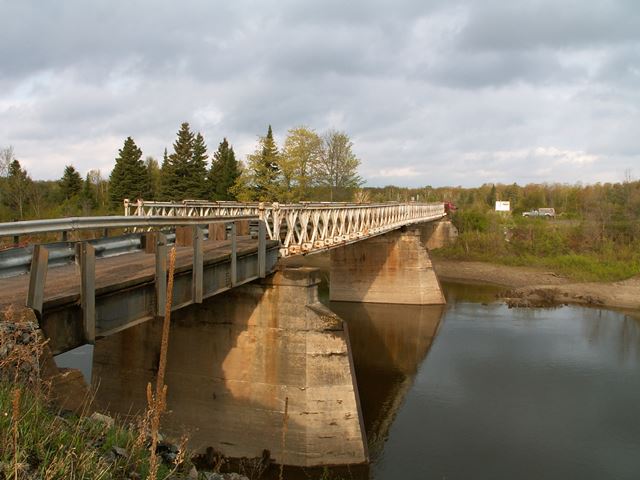We Recommend:
Bach Steel - Experts at historic truss bridge restoration.
BridgeHunter.com Phase 1 is released to the public! - Visit Now
Shewfelt Bridge
Old Goulais Road Bridge

Primary Photographer(s): Nathan Holth
Bridge Documented: May 13, 2006
Not Available or Not Applicable
Not Available
Not Available
Not Available
2 Main Span(s) and 2 Approach Span(s)
Not Applicable

View Information About HSR Ratings
Bridge Documentation
This bridge no longer exists!
This heritage bridge was demolished and replaced in 2011!
Note that the name of the current vehicular road is "Old Goulais Bay Road" and that this bridge is the current and only bridge serving the road. The "old" portion of the name means that this may have been the old highway route up before nearby TC-17 assumed its current alignment east of this road. Although not a signed King's Highway today, this road is under MTO jurisdiction.
This was a significant example of a Bailey truss bridge. It featured two main Bailey truss spans, plus one small steel stringer approach at both ends of the bridge. 1944 dates on this bridge's steel allowed for dating to the trusses on this bridge. Note however it is possible that although the trusses were fabricated in 1944, that this bridge was not erected here until a later date. Bailey bridges were designed to be temporary and relocated, so this bridge likely had a former life before it was moved here. Regardless of its origin, the structure is significant as a very old example of the structure type. Since the Bailey truss was designed as part of World War II, it is impossible for a Bailey bridge to be older than WWII. The Old Goulais Bay Road Bridge sits on large concrete piers which may be from a former bridge. The bridge is a single story, double truss structure.
Scott Steeves contacted HistoricBridges.org a few months after the May 13, 2006 field visit with information that this bridge had been closed to all traffic, due to a serious structural problem.
Mr. Steeves reports that "Sometime between May and July the southern side of the central pier of the bridge has begun to sink and the bridge now has an impressive lateral lean to it. The bridge is now closed to both vehicular and pedestrian traffic, and I am sure the MTO (who owns Old Goulais Bay Road as an unposted highway) is now slowly formulating a replacement strategy."
During the visit in May, things that may have been the beginning of the problem were visible. A look at zoomed portal views of the bridge shows that the south side trusses were lower in the middle, while the north side at the center, the trusses are higher. In addition, if you follow the lines in the concrete of the piers, they do not parallel the river, and instead are angled downward to the south. See this diagram here. The fate of this bridge is similar to that of the State Street Bridge in Michigan, a through truss whose pier had sunk at one end, twisting one of its two truss spans.
Unlike the State Street Bridge however, this bridge was reportedly demolished and replaced with a "single span modular bridge" in 2011 which may imply that a modern Bailey truss replaced the heritage bridge. If so, this should not be considered a form of preservation, since modern Bailey trusses often lack key details found in genuine Bailey bridges produced during the World War II period. These details may include things like transom clamps, traditional transom design, and details around the end posts that in the original design included jacking attachments and such. Proof of this can be seen elsewhere in this region of Ontario, as several other modern Bailey trusses were observed in this area. All these bridges have yellow warning signs reading "Bailey Bridge" before you approach these bridges. Apparently, these signs are just to warn people of narrow widths and unusual deck materials. Funny that they read "Bailey Bridge" instead of "Narrow Bridge" or "Caution - Metal Grate Deck" and etc.
![]()
Photo Galleries and Videos: Shewfelt Bridge
Bridge Photo-Documentation
Original / Full Size PhotosA collection of overview and detail photos. This gallery offers photos in the highest available resolution and file size in a touch-friendly popup viewer.
Alternatively, Browse Without Using Viewer
![]()
Bridge Photo-Documentation
Mobile Optimized PhotosA collection of overview and detail photos. This gallery features data-friendly, fast-loading photos in a touch-friendly popup viewer.
Alternatively, Browse Without Using Viewer
![]()
Maps and Links: Shewfelt Bridge
This historic bridge has been demolished. This map is shown for reference purposes only.
Coordinates (Latitude, Longitude):
Search For Additional Bridge Listings:
Additional Maps:
Google Streetview (If Available)
GeoHack (Additional Links and Coordinates)
Apple Maps (Via DuckDuckGo Search)
Apple Maps (Apple devices only)
Android: Open Location In Your Map or GPS App
Flickr Gallery (Find Nearby Photos)
Wikimedia Commons (Find Nearby Photos)
Directions Via Sygic For Android
Directions Via Sygic For iOS and Android Dolphin Browser

